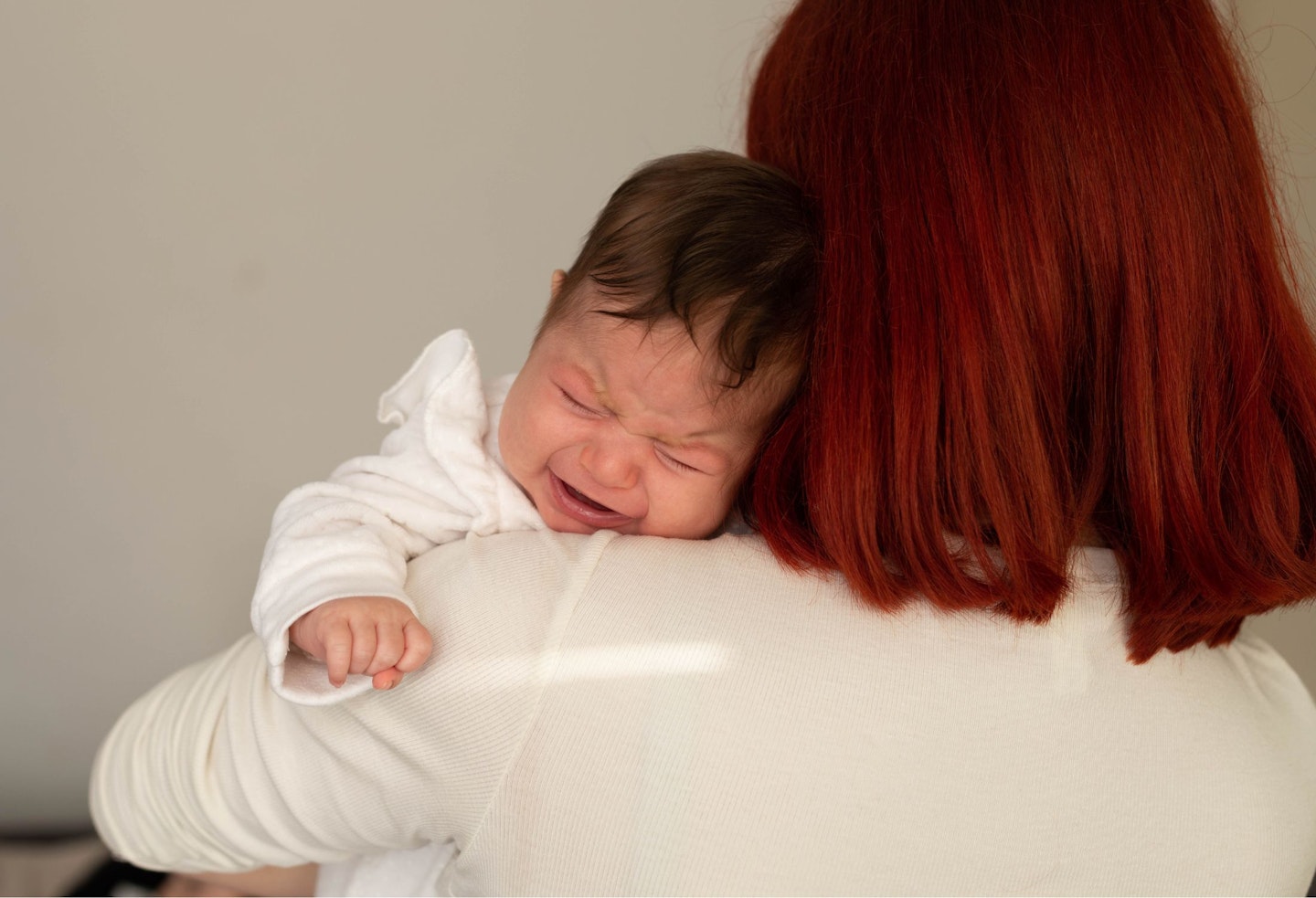
Medically Reviewed by: Lesley Bland BA (Hons), BSc (Hons) Midwifery Studies
Reflux in babies is very common, but not as much is known about silent reflux in babies. Although seeing your baby be sick or spitting milk back up after feeding can be alarming, it is very common and this occurs simply because your child's food pipe isn't fully developed, causing milk to come back up.
As a parent of a newborn, seeing them distressed or upset is one of the hardest things you have to go through and reflux can make babies very uncomfortable and irritable, often resulting in frequent crying. This excessive and uncontrollable crying, often caused by general stress and abdominal discomfort, is referred to as colic in babies and many believe there is a link between the two. But what about silent reflux?
Here we spoke to Chalie Blyth, founder of The Healthy Child Co. and a dedicated specialist public health nurse (health visitor) to explain everything you need to know about silent reflux in babies.

What is silent reflux?
Silent reflux is effectively the same as reflux but the baby does not vomit or spit the milk back up so the symptoms are much less obvious. This means that stomach acid is causing discomfort, often behind the breastbone. It can make your baby's throat sore or burn, so if they are coughing then this is one of the main symptoms that they do tend to display.
As symptoms of silent reflux do not appear, it is a relatively unknown phenomenon which means it might go unnoticed, misdiagnosed or mismanaged. However, as a parent, you're likely to know your baby and when something is wrong.
Traditional acid reflux is known as gastroesophageal reflux disease (GERD), whereas silent reflux is often referred to as laryngopharyngeal reflux (LPR). According to Web MD "Silent reflux is common in infants because their sphincters are undeveloped, they have a shorter oesophagus, and they lie down much of the time."
What causes silent reflux in babies?
Silent reflux happens when stomach acid flows back up into the oesophagus without the obvious symptom of spitting up. This occurs because a baby’s digestive system is still developing, and the muscle that keeps stomach contents down (the lower oesophageal sphincter) is not yet fully matured. Factors like frequent lying down and swallowing air during feeds can also contribute.

Signs of reflux in babies
Charlie explains, "Silent reflux in babies occurs when stomach acid flows back up the oesophagus without causing obvious vomit or posseting, making it harder to diagnose and recognise." Here she shares some common signs and symptoms:
-
Frequent crying or fussiness during or after feeds
-
Refusing feeds or taking only small amounts
-
Arching the back or turning away from the bottle or breast
-
Gulping, choking, or gagging during feeds
-
Difficulty settling or staying asleep
-
Frequent night waking, especially with discomfort
-
Preferring to sleep upright or in a parent's arms
-
Chronic coughing or throat clearing
-
Frequent baby hiccups
-
Swallowing repeatedly, as if clearing the throat
-
Acidic-smelling breath
-
Bloating or gassiness
Charlie cautions, "Since silent reflux has similar symptoms for colic, cows milk protein allergy and normal new-born fussiness, it's important to monitor symptoms and discuss concerns with a healthcare professional."
Complications caused by silent reflux
"Most babies outgrow silent reflux by their first birthday as their digestive system matures. Long term complications are extremely rare," says Charlie.
She adds, "Silent reflux in babies can cause long-term issues like chest infections, weight problems, and inflammation of the oesophagus. Most babies with silent reflux do not experience these complications, especially with proper management. Therefore, its essential to seek appropriate support."
Examples of other complications in babies are:
• Narrowing of the area below the vocal cords
• Contact ulcers
• Recurrent ear infections from problems with eustachian tube function
• A lasting buildup of middle ear fluid
If your baby has persistent symptoms then it is best to visit your GP to seek advice and treatment for silent reflux.
How is silent reflux diagnosed and treated in newborns?
Healthcare professionals diagnose silent reflux by assessing your baby's symptoms, feeding patterns, weight gain, and any signs of discomfort. A GP may conduct a physical examination to rule out other conditions. "Most babies don't need specific treatment for reflux," says Charlie. "Reflux improves as they grow, often resolving by 12 months of age."
While treatment isn’t always necessary, Charlie shares three key management strategies:
-
"Hold your baby upright during feeding and for as long as possible afterward."
-
"Burp your baby regularly during feeds."
-
"For formula-fed babies, offer smaller, more frequent feeds."
If formula feeding, a GP or health visitor may recommend a thicker formula to help reduce reflux. "If these measures don't alleviate symptoms, or if your baby experiences severe discomfort, isn't gaining weight, or has other concerning symptoms, consult a GP or Health Visitor," Charlie advises.

To help with reflux in babies, you can try:
1. Gentle movement
Putting your baby in their sling or pushchair and gently moving them can help with reflux and encourage them to settle. Babies often prefer moving to sitting or lying still. Crying tends to make reflux worse and keeping your baby upright will hopefully ensure they cry less because they are close to you.
2. Give frequent, small feeds
If your baby is formula-fed, feed them less but more frequently. This will stop them from getting too full which will mean they are less likely to struggle to digest the milk.
3. Avoid tight clothing
Tight clothing can also put extra pressure on babies' sensitive tummies so it is best to put them in loose clothing if they frequently suffer from reflux.
4. Have some quiet time
After a feed try and have half an hour of quiet and still relaxing time with your baby. This is especially important for formula-fed babies as it is digested at a slower rate than breastmilk so they might need longer to settle.
5. Try and keep your baby upright
Try and keep your baby upright for half an hour after a feed. This can reduce reflux as gravity is more likely to keep the milk down.
6. Baby massage
Baby massage has been known to improve symptoms of reflux and colic. According to the NCT, baby massage has several other benefits to parents including boosting the bond with baby and improving sleep and interaction with your little one.
7. Consider how they travel
Your baby's car seat or travel systems can often make reflux worse as babies tend to slump when in them, especially when asleep. Slumping puts more pressure on their precious tummies and they are more likely to feel the pain of rising acid. Try to avoid travelling directly after feeding and buy a car seat that prevents slumping as much as possible.
8. Sleeping position
If they are old enough to roll over, it is safe for your baby to sleep on their side which might help with the symptoms of reflux. However, do not put your child on their side unless you are sure they do have the ability to roll.
9. Burp your baby
If you bottle feed your baby, you can try burping your baby gently every few minutes during a feed. If you are breastfeeding, try gentle burping after a feed or if you are swapping sides.
FAQs on silent reflux in babies
How do I tell if my baby has silent reflux?
Silent reflux symptoms include frequent swallowing, coughing, gagging, irritability during or after feeds, arching the back, and difficulty sleeping. Unlike regular reflux, there’s little to no spit-up.
Is silent reflux in babies worse at night?
Yes, lying flat can make reflux worse, as stomach acid has an easier time flowing back up. Keeping your baby upright after feeds may help.
What worsens silent reflux in babies?
Overfeeding, lying down too soon after feeds, swallowing air during feeds, and certain foods (for breastfeeding parents) can make symptoms worse.
Does tummy time help with silent reflux?
Yes, tummy time strengthens neck and core muscles, which can aid digestion and reduce reflux episodes. However, it should be done when your baby is alert and not right after feeding.
Does gripe water help with silent reflux?
Gripe water may help with gas and discomfort, but there’s no strong evidence that it relieves silent reflux symptoms. Always check with your GP before using it.
About the expert
Charlie Blyth is the founder of The Healthy Child Co and a dedicated specialist public health nurse (Health Visitor) with over 13 years of experience in the NHS, including 9 years as a health visitor, where she supported hundreds of families in the community. With a deep commitment to child health and development, Charlie is passionate about challenging outdated parenting methods and advocating for evidence-based practices to promote responsive parenting and positive child growth.
About the author
Catriona Watson originally joined the team as an Editorial Assistant to work on the 2019 M&B Awards. As a Digital Writer, she has written and updated hundreds of articles on the site from medical explainers to celebs news and shopping galleries.
